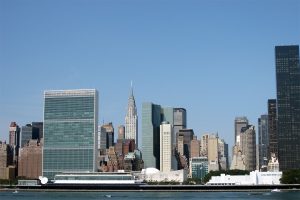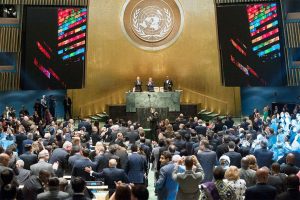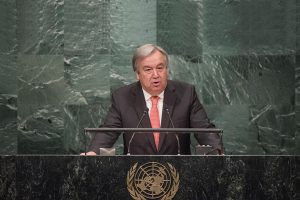14 June 2019: With 100 days until the UNGA’s 74th session opens, UN Member States were briefed on preparations for five events that will convene during the high-level week in September 2019. The briefing was convened by the UN General Assembly (UNGA) President and included updates from UN officials and co-facilitators for the high-level meetings.
The five meetings convening during the UNGA 74 high-level week are: the High-level Meeting on Universal Health Coverage (UHC) and the UN Secretary-General’s Climate Action Summit (23 September); the SDG Summit, or the UN High-level Political Forum on Sustainable Development (HLPF) under the auspices of the UNGA (24-25 September); the High-level Dialogue on Financing for Development (26 September); and the High-level Midterm Review of the SAMOA Pathway (27 September). These meetings take place alongside the 74th general debate, which will begin on Tuesday, 24 September.
Mohammed said the GSDR identifies entry points that could unleash the greatest benefits across the SDGs, while minimizing trade-offs.
Amina Mohammed, UN Deputy Secretary-General, remarked that the five meetings of September’s high-level week “are deeply interconnected” and seek to generate ambitious SDG action that leaves no one behind. While progress has been made across a number of the SDGs since 2015, she said, further and much faster progress must be made to achieve the SDGs by 2030. She noted that the UN Secretary-General’s SDG Progress Report and the 2019 Global Sustainable Development Report (GSDR) provide concrete suggestions on the way ahead, including more ambitious action on cross-cutting issues and levers of change such as finance, data, behavior change, resilience, effective institutions, technology and local action. In addition, she said the GSDR also identifies specific “entry points” on food, energy, urban development, and sustainable and just economies, which could unleash the greatest benefits across the SDGs, while minimizing trade-offs. She called on all governments and stakeholders to come to each of the high-level week meetings with strong acceleration commitments that are credible, actionable and transformative.
As part of UN preparations for the high-level week, Mohammed reported that the UN’s Department of Global Communications is working with partners to maximize outreach, including through the UN Information Centers, the SDG Media Zone and the SDG Media Compact, which will bring content on the high-level week “to some 50 of the world’s leading media and entertainment outlets.”
On the SDG Summit, UNGA President Maria Fernanda Espinosa Garces said that following consultations with Member States and other stakeholders, and guided by relevant UNGA resolutions, the Summit will be informed by the SDG Progress Report and the GSDR, which will “provide the main inputs for the event.” She also noted her recommendation of modalities for the Summit, which was circulated to Member States on 30 May 2019. She said the SDG Summit will include an opening session, two plenary sessions for statements by “groups of Member States,” six hour-long thematic “Leaders Dialogues” to share national experiences and provide political guidance on implementation, and a closing session. In addition, a series of “leaving no one behind” short videos will be featured during the Summit to highlight the needs of different groups of people, including the most vulnerable. A delegate responded that the topics of these videos, as indicated in the recommended modalities document, focus only on the social dimension of sustainable development, and he suggested that they also cover the environmental and economic dimensions.
Espinosa also highlighted the “SDG Acceleration Hub,” which is explained in an information note, and on which more information will be provided “in the coming weeks.” She encouraged delegates to register their SDG commitments and “acceleration actions” online. Liu Zhenmin, UN Under-Secretary-General for Economic and Social Affairs, explained that acceleration actions can be announced both in the lead-up to the Summit and during the Summit itself.
On the political declaration that will be adopted during the SDG Summit, Sheila Gweneth Carey, Permanent Representative of Bahamas, also on behalf of Olof Skoog, Permanent Representative of Sweden, reported that a first reading of the zero draft of the political declaration took place on 7 June. She noted a broad agreement on the declaration, including on the need to have a lofty and concise outcome document while addressing the most important issues, based on the findings of the GSDR and the SDG progress report. She said “everyone” wants the declaration to be adopted by consensus. The next informal meeting to discuss the revised draft was scheduled for 17 June.
On stakeholder participation in the Summit, G-77/China said it should be in line with the principles of the UNGA and determined on a “non-objection” basis. The EU stressed the importance of including stakeholders in the Summit considering their role for the successful implementation of the 2030 Agenda.
UN Economic and Social Council (ECOSOC) President Inga Rhonda King provided updates on the July 2019 session of the HLPF that will be convened under ECOSOC’s auspices, noting that the SDGs to be examined at that meeting (Goals 4, 8, 10, 13, 16 and 17) will inform the overall review of SDG progress at the Summit. She added that the July HLPF will include two sessions that contribute directly to Summit, namely on lessons learned from the first four years of voluntary national reviews (VNRs), and lessons from the first cycle of the HLPF. She said extensive and high-quality summaries of the July HLPF will be produced.
King announced that she will convene a meeting in the afternoon of 26 June 2019 regarding the July session of the HLPF, as well as the ECOSOC High-level segment that will follow the HLPF on 19 July, and the Integration Segment scheduled to take place the day before the HLPF on 8 July.
On VNRs, King reported that between 2016 and 2019, 142 countries will have presented their reviews, and she called for VNRs to start showing the impacts of SDG implementation. She also reported that she has established a Group of Friends on the VNRs and the follow-up and review of the HLPF, chaired by Mexico. The Group is aimed at increasing peer learning and sharing best practices and lessons learned, in order to help address the challenge of having only 30 minutes during which to present and discuss each VNR during the HLPF. King reported that the Group has met once, and she encouraged other States to join.
Co-facilitators and officials briefed delegates on other events of the UNGA high-level week. On the High-Level Meeting on UHC, Kaha Imnadze (Georgia) said the meeting will adopt a political declaration on UHC, and governments have conducted the first reading of the zero draft. The co-facilitators aim to complete the consultation process by early July. The other co-facilitator for the UHC meeting is Vitavas Srivihok (Thailand).
On the UN Secretary-General’s Climate Action Summit, Anne-Sophie Cerisola, Deputy Special Envoy for the Summit, announced that climate-related events will take place right before the Summit, on Saturday and Sunday, 21 and 22 September. Cerisola recalled that nine coalitions have been established for the Summit, and she informed delegates that an information note will be shared during the week of 17 June, providing details on a meeting in Abu Dhabi. This stocktaking meeting to prepare for the Climate Action Summit will convene from 30 June to 1 July 2019.
On the High-level Dialogue on Financing for Development, Martha Ama Akyaa Pobee (Ghana) outlined recommendations stemming from consultations with UN Member States and other stakeholders, including that:
- an action-oriented outcome document is needed;
- the dialogue should not duplicate the ECOSOC Forum on Financing for Development Follow-up (FfD Forum), but it should build on the outcome of the Forum;
- the meeting should be coherent and have direct links with the other events of the UNGA high-level week;
- it should consider debt sustainability and illicit financial flows, among other topics;
- it should be an opportunity to launch concrete actions for the achievement of the SDGs; and
- engagement with the private sector is needed, considering the requirement of USD 2.5 trillion for SDG implementation each year.
The other co-facilitator for the FfD Dialogue is Marc-Andre Blanchard (Canada).
On the SAMOA Pathway high-level midterm review, Satyendra Prasad (Fiji) said a revised draft of the political declaration to be adopted at the meeting should be circulated by 14 June, and the process should be completed by early July. He said the declaration should focus on political commitments, and balance a stocktaking with forward-looking perspectives. He also stressed the need to ensure high-level participation in the review, since it will take place at the end of the high-level week. The other co-facilitator for the SAMOA review meeting is Geraldine Byrne Nason (Ireland).
UNGA President Espinosa encouraged governments to log partnerships for SIDS on the online platform that has been created in support of the SAMOA Pathway. [SDG Knowledge Hub Sources]





